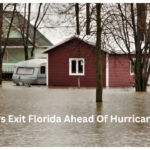Florida Motorist Pay More Than Double Their Premiums than Ohio

Exploring the Majestic Landscapes of Iceland
July 14, 2023
Farmers Exit Florida Ahead Of Hurricane Season
July 14, 2023Table of Contents
ToggleThe American Auto Insurance Lottery Reveals Why Motorists in Florida Pay More Than Double Their Premiums than Ohio
Florida Motorist Pay More Than Double Their Premiums than Ohio.
Florida motorists pay the highest car insurance in any state, according to the report. Drivers in the Sunshine State will have to pay twice as much as in Ohio. The figures show that auto insurance is now one of the main drivers of inflation.

Motorists are facing a car insurance lottery where premiums vary by as much as $1,500 a year, according to a recent analysis. A report from car subscription company FINN said Florida residents faced the highest costs, with an average annual premium of $2,560 for full coverage.
It was followed by Louisiana, Delaware, Michigan, and California, where premiums averaged $2,546, $2,137, $2,133, and $2,115, respectively.
This comes after it emerged that auto insurance is now a major contributor to inflation, rising 16.9% last year, according to the US Department of Labor. Insurers attribute higher premiums to higher repair costs, higher medical bills, more litigation, and more accidents.
Since the pandemic, the number of road traffic accidents has risen sharply, with the death toll increasing by 10.5% between 2020 and 2021. But the discrepancy between states is attributed to road safety as well as the number of uninsured drivers in each state.
For example, the report notes that Florida has the highest proportion of uninsured drivers. About 20 percent of motorists are uncovered. This means that those who take out insurance face an unfair premium to account for increased risks.
Auto insurance in Florida has jumped 88 percent over the past ten years, the highest of any state. It also suffers from the highest inflation rate in the US. The researchers calculated that annual premiums in the Sunshine State could reach $4,813 by 2033 if the current trend continues.
Similarly, 10 percent of drivers in Louisiana are also uninsured, adding to the cost of insurance premiums.
What’s more, the report notes that Pelican State is home to a disproportionate number of vehicle-related lawsuits. Meanwhile, low costs in Ohio were attributed to safe roads and a “highly competitive insurance market”.
Maine was ranked second due to its low population density, which reduces the risk of collisions.
Experts have previously warned that US insurers are desperate to recover losses incurred last year.
Auto insurers lost 12 cents for every dollar paid in premiums, according to S&P Global. And the United State’s largest auto insurance company, State Farm, lost 28 cents for every dollar written out last year, corresponding to a $13 billion underwriting loss for its auto division.
Speaking of unprecedented underwriting losses last year, a State Farm spokesman said, “We continue to adjust…to make sure the price is commensurate with the risk.”
Neil Aldridge, executive director of the trade association for the National Mutual Insurance Companies, told the Wall Street Journal: “This is probably the worst period for auto insurers in at least 30 years.”
But consumer protection authorities are criticizing insurers for increasing spending as households already grapple with the rising cost of living.
Carmen Balber, chief executive of Consumer Watchdog Group, told the Wall Street Journal: “Rampant interest rate hikes are hitting American wallets, and those least able to pay are bearing the brunt.”
FAQ
- Is Florida more expensive for car insurance?
Florida drivers pay higher car insurance premiums than the national average. The state’s minimum liability requirements are also quite low, meaning that drivers in the state may want to consider purchasing full coverage policies that include both collision and all-around coverage to give them full protection.
- Why did my Florida car insurance go up so much?
The number of uninsured drivers in the state, increasing healthcare costs, and Florida experiencing more severe weather all contributed to rising premiums
- Is auto insurance cheaper in Ohio or Florida?
Yes, auto insurance is cheaper in Ohio than in Florida. Auto insurance rates in Ohio average $1,442 less per year than in Florida, in part because Ohio is generally less risky for drivers due to lower rates of auto accidents and condition-related vehicle damage weather.




